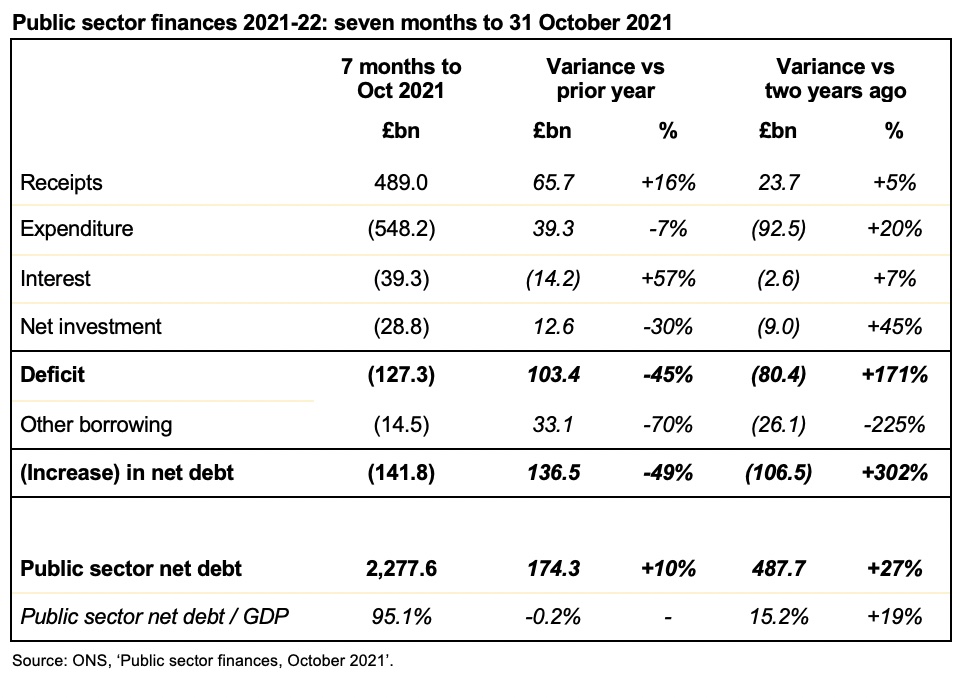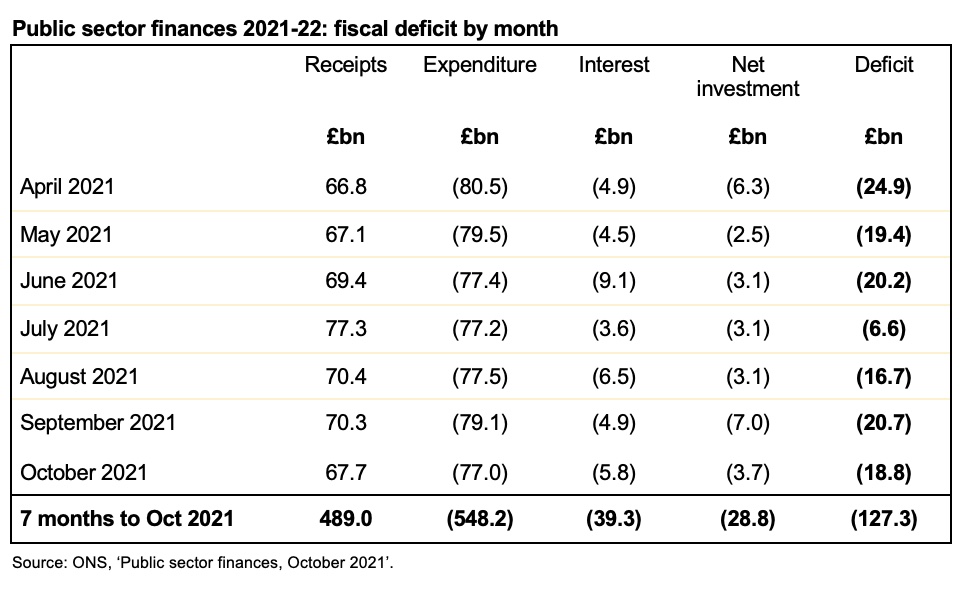The monthly public sector deficit was flat at £18.8bn in October but a last-minute rush by banks to access cheap finance caused public sector net debt to jump by £68.7bn to £2,277.6bn.
The public sector finances for October 2021 released on Friday 18 November reported a monthly deficit of £18.8bn, slightly better than the £19.0bn reported for October 2020 but higher than the £11.6bn deficit in October 2019.
This brings the cumulative deficit for the first seven months of the financial year to £127.3bn compared with £230.7bn last year and £46.9bn for the equivalent period two years ago.
Public sector net debt increased from £2,208.9bn at the end of September to £2,277.6bn or 95.1% of GDP at the end of October. This is £141.8bn higher than at the start of the financial year and an increase of £484.5bn over March 2020.
The increase in public sector net debt of £68.7bn in the month includes £57.3bn to funding lending to banks who rushed to borrow under the ‘Term Funding Scheme with additional incentives for SMEs’ (TFSME) before the extended drawdown period ended on 31 October 2021. A further £26.9bn will be recorded in November for cash movements after the cut-off date, bringing the total amount financed through the TFSME to £193.4bn on 10 November 2021.
As in previous months this financial year, the deficit came in below the forecast for 2021-22 prepared by the Office for Budget Responsibility (OBR) in March 2021 but was in line with the OBR’s revised forecast issued in October 2021 alongside the Autumn Budget and Spending Review 2021.
Cumulative receipts in the first seven months of the 2021-22 financial year amounted to £489.0bn, £65.7bn or 16% higher than a year previously, but only £23.7bn or 5% above the level seen a year before that in 2019-20. At the same time cumulative expenditure excluding interest of £548.2bn was £39.3bn or 7% lower than the first seven months of 2020-21, but £92.5bn or 20% higher than the same period two years ago.
Interest amounted to £39.3bn in the seven months to October 2021, £14.2bn or 57% higher than the same period in 2020-21, principally because of higher inflation affecting index-linked gilts. Despite debt being 24% higher than two years ago, interest costs were only £2.6bn or 7% more than the equivalent seven months ended 31 October 2019.
Cumulative net public sector investment in the seven months to October 2021 was £28.8bn. This was £12.6bn less than the £41.4bn in the first seven months of last year, which included around £17bn on coronavirus lending that is not expected to be recovered. Investment was £9.0bn or 45% more than two years ago, principally reflecting a higher level of capital expenditure.
Debt increased by £141.8bn since the start of the financial year, £14.5bn more than the deficit. This reflects funding to cover outflows on lending to business, including to banks through the Term Funding Scheme, and student loans offset by the receipt of taxes deferred last year and the repayment of coronavirus loans taken out during the course of the pandemic.
Alison Ring, ICAEW Public Sector Director, said: “Today’s public finance numbers show a deficit of £18.8bn in October, which is in line with the revised forecasts published by the Office for Budget Responsibility last month. The deficit has stopped growing now that the furlough and other pandemic support schemes have finished.
“However, a last-minute rush by banks to obtain cheap loans for small and medium enterprises, before the application deadline on 31 October, caused government debt to jump by £68.7bn last month. These loans should help businesses navigate choppy economic waters with rapidly rising inflation, as well as supply chain and staffing challenges. Nonetheless, the Chancellor will need to continue watching events closely to see if he will need to reintroduce any pandemic support schemes.”

Caution is needed with respect to the numbers published by the ONS, which are expected to be repeatedly revised as estimates are refined and gaps in the underlying data are filled.
The ONS made a number of revisions to prior month and prior year fiscal numbers to reflect revisions to estimates. These had the effect of increasing the reported fiscal deficit for the six months to September 2021 from £108.1bn to £108.5bn and the deficit for the year ended 31 March 2021 from £319.9bn to £323.1bn.
